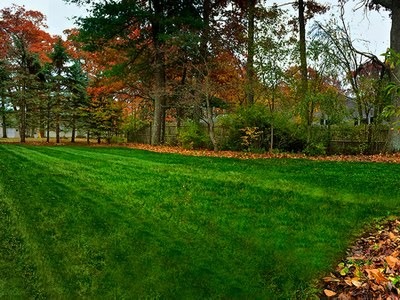What to do with Fall Leaves

There are many benefits to utilizing the leaves in your landscape; however, too many can and will kill the lawn or desirable plants. Even if you don’t have trees in your yard, there will likely be some leaves that are blown in from your neighbors. Before the leaves fall is a good time to plan for what to do with your leaves.
Falling leaves are an excellent source of organic matter to replenish nutrients in soil and improve the soil structure, but in a lawn setting, they can quickly create a mat that will kill the grass underneath. One of the best ways to utilize leaves in your lawn is to use a method called mulch mowing. As you get a thin layer of leaves on top of your grass, one to two inches, not 6-8” of leaves, mow your lawn with the bagger off. The mower will chop the leaves into small bits that can fall through the grass to land on the soil surface. These pieces will break down over the winter and add to the soil. You can tell you have been successful with mulch mowing when you look behind you and see mostly grass with a few leaves. If you see mostly leaves, you probably waited too long. If you have many trees in your yard, this may have to be done multiple times a week when the leaves fall the most.
Leaves are an excellent addition to any compost pile. For the best results, mulch the leaves so they are in smaller pieces before putting them in the compost pile, allowing them to break down faster. You can also add mulched leaves directly to the garden and either leave them on the surface or till them into the soil to break down for next year. Leaves can be an excellent mulch around perennials and other flower beds. They help insulate the soil and protect the delicate crowns of tender plants from the freeze/thaw cycles we see in the spring.
If possible, leave some leaves sitting for native pollinators and other beneficial insects to overwinter in. Many of our good bugs utilize leaves and standing plant material to survive till next spring. No matter how you use your leaves, make a plan on what to do with them so you can avoid sending them to the landfill this fall.

Have questions? Contact our office where our Horticulture Extension Agent will assist you with questions.
Phone: (316) 321-9660
Email: callae@ksu.edu